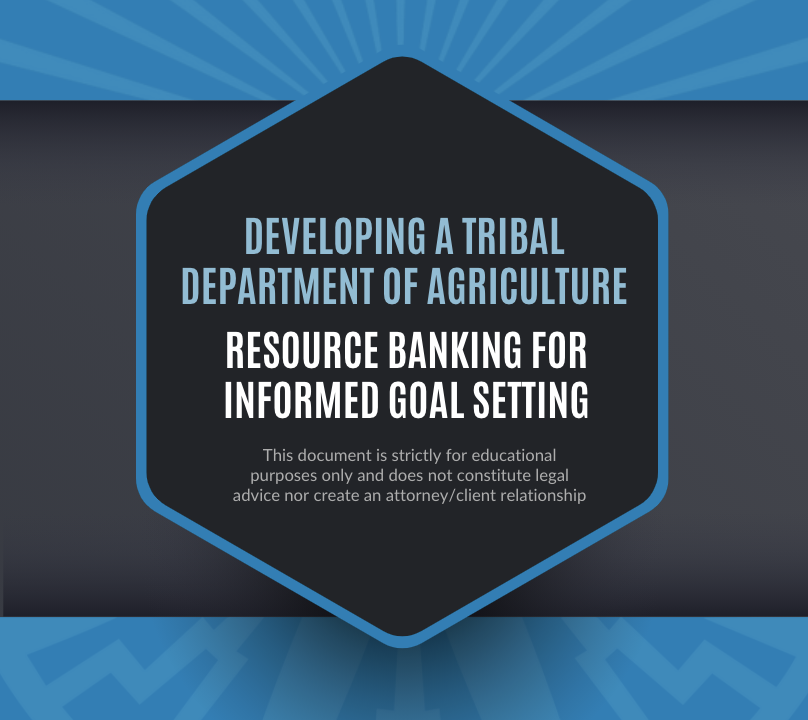This document is strictly for educational purposes only and does not constitute legal advice nor create an attorney/client relationship.
This worksheet is intended to assist in the development of an inventory of resources available to the tribe. In order to set practical and realistic goals for a new Department of Agriculture, information about existing operations and enterprises, tribal assets, and available guidance materials should be compiled and reviewed for more complete decision making and goal setting. This document is intended for internal guidance as sensitive material may be compiled as a result.
By reviewing tribally specific and general resources, tribal decision makers will be able to analyze the information and then determine/prioritize the objectives of the Department of Agriculture such as:
- Service Provision
- Revenue Generation
- Vertical Integration/Self-Sourcing
- Regulatory Oversight
- Economic Development
While a Department of Agriculture’s operations can meet multiple objectives, it is a good idea to be explicit about the Department’s main priority. For instance, if a Department’s priority is revenue generation from crop production, donations or discounted sales of those crops as a part of service provisions (direct nutrition offerings to tribal citizens) would undercut the primary goal of the Department. If a Department’s goal is Service Provision like feeding tribal citizens or seed sharing through production/growing activities, then there may be a funding need that the Department would not be able to independently sustain and would require appropriations.
Tribal Inventory
Land
Example
400 acres in fee, adjacent to 600 acres in trust, 130 currently arable, used for hay meadow, two ponds on property with disabled pump on one pond. 45 minutes/40 miles from tribal campus, possible trespass issues from hunters.
List how many acres/parcels? In trust, fee, restricted status? How many leased parcels acres? Any appropriate land currently available for acquisition by purchase, by lease, by cooperative agreement to manage like on rez or adjacent BLM properties, National Forest?; Then per parcel of particular interest: How many arable acres? Location of land/proximity to seat of tribal government/operations? Currently in production/operation? What is produced or operated on the parcel? Best use? Any potential issues with the land.
Facilities/Buildings
Example
One 10,000 sq ft metal barn buildings, former dairy barn, used for hay storage, connected to electricity, dilapidated ofce/storage space, 6 individual stalls and one large stall, two overhead garage doors on south and west side, large double sliding barn doors on North and East side, textured concrete oor, 50 minutes/ 44 miles from tribal campus, 8 minutes from nearest town, connected to cattle working pens, on ranch site.
List Barns, Office Space, Warehouses, Storage, residential buildings, retail space, fairgrounds, event spaces, etc… Square footage? Utilities? Proximity to population centers/tribal citizens? Condition of each building.
Equipment
Example
One Peterbilt tractor trailer, 1989 model, in Fleet Surplus yard. One John Deere 450M Round Baler, 2019 model, Natural Resources program inventory, on tribal campus storage lot.
List inventory of equipment for possible Dept. of Ag use like vehicles, trailers, tractors, ag machinery, chutes, implements, sprayers, processing/packing equipment, computers, tablets, printers, drones, refrigeration units, backhoes, dozers, feed mixers, generators, pumps, welders, boats, etc… List Item then indicate, if known, brand, model, year, condition and location (program and/or physical)
Expertise
List any people accessible by the tribe with information regarding agriculture, food/nutrition, program operations, tribal policy, etc… These could be current or former employees, current or former elected officials, elders with historical knowledge, tribal scholars, educators/researchers, extension agents, BIA personnel, adjacent land holders. List name, position, topic of expertise, and contact information.
Water
List Rights to water like inherent rights/tribal treaty rights/contracted rights/purchased rights/permitted rights; Bodies of water available (ocean, rivers, streams, lakes, ponds, ground water, municipal water sources, seasonal water sources, water collection locations), access to water (land on or near rivers/streams, utility infrastructure, irrigation, wells, transported water); annual precipitation averages; water management districts/entities (municipal, tribal, IHS, commissions, boards, county, state, BLM/Bureau of Reclamation and what jurisdictional issues need to be considered).
Support
List Political (council, chief/executive, independent tribal commissions/agencies, external governments, Federal elected representatives); Population- tribal citizens, tribal ag producers, nonnative persons living on reservation or tribal lands, etc; Partners- (investors, chambers of commerce, economic development incubators, private funders, partner governments, nonprofits/ nongovernment operations); BIA staff.
Personnel/Labor
List current staff, potential labor pool, possible created positions, Employment and training programs, Summer youth workers, internships, possible shared staff with other tribes/governments.
Enterprises/Organizations
List Tribal programs like current ag production or processing, seed saving, nutrition programs, conservation activities, cooperative management, wildlife, realty land services, GIS, Environmental services, rangeland management, permitting/leasing; BIA programs that could be compacted or contracted; individual tribal citizen operations like cattle, crops, value added operations like processing, small scale in home commercial activity, etc..; individual subsistence or hobby agriculture like family gardens, wild harvest, ag product trade, seed saving, etc; also list current programs that involve land, agriculture, food, forestry, access to credit like CDFIs, etc…
Guidance Information and Materials:
- Existing Agriculture Resource Management Plan
- Existing Integrated Resource Management Plan
- Community Feedback, Comments, Ideas, Reflections
- Tribal Staff Feedback, Comments, Ideas, Reflections
- Tribal Strategic Plans (specific to agriculture, food, or natural resources)
- Elected Official policy goals/campaign platforms (Health, Nutrition, Economic Development, Cultural Preservation)
- Cultural/Historical Knowledge & Practices (Harvest practices, take ratios, seed saving methods, conditions of sale/trade
Possible Opportunities:
- Self-Governance funds: List currently held or possibility to negotiate for in next funding agreement
- BIA Self-compacted/Self-contracted programs: ID Currently operated self-contracted/compacted program and possible future programs to self-compact. Reference BIA program website.
- Possible Tribal allocations from general revenue: Gaming revenue, interest generated from permanent fund, tax revenue, etc…
- Federal funds (USDA/Farm Bill, EPA, DOI)- EQIP, LAMP, Rural Development, RCDBG funds, etc…
- Enterprise revenue: Retail operation funds, Tourism funds, agribusiness funds
- Private Grant Funding (NAAF, FNDI, Non-profit funders, etc)
- Employment and Training programs: 477 programs, Federally funded E &T Programs, Nutrition E & T programs like SNAP/FDPIR, summer youth worker program
- Loans/Credit opportunities:
Possible Partners:
- Tribal Cooperatives/NGOs
- Other Tribes: List nearby or similarly situated
- City, County, or State Governments: List, on or near reservation/tribal lands/assets
- Educational Institutions like Tribal Colleges, Land Grant Units, and Career Techs
External Guidance Materials:
- Webinars
- Scaling Up Videos
- Model Tribal Food and Agriculture Code
- Intertribal Agriculture Council
- Technical Assistance Personnel Network
- Conservation Planning Tool Kit
- American Indian Foods Export Program
- Native Food Connection
- Made/Produced by American Indians Trademark
- First Nations Development Institute Food Sovereignty Assessment

